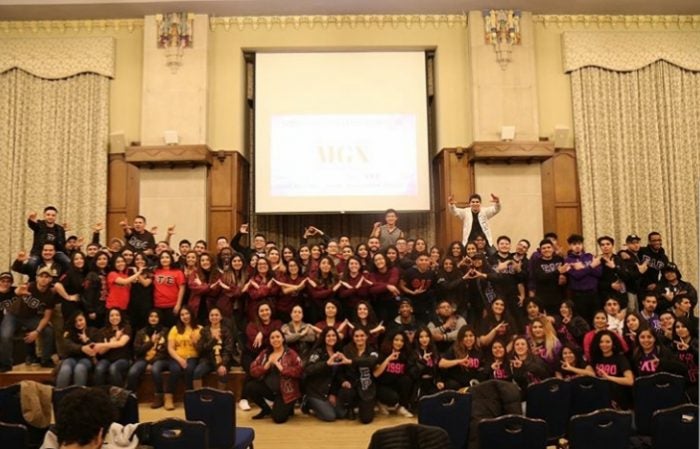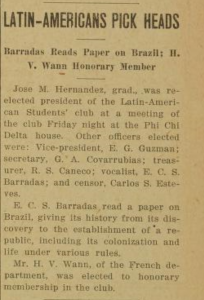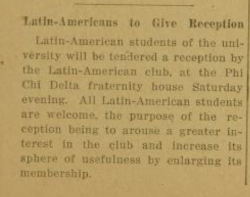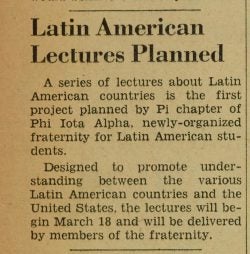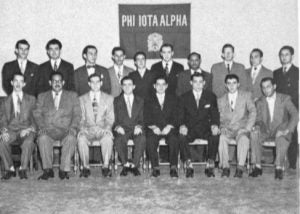Waves of Latinx Greek Life: A Subculture at the University of Michigan
By: Antonio Gallegos
Fraternity and Sorority life has a long history here at the University of Michigan. Since 1845, just 8 years after the University of Michigan was moved to the city of Ann Arbor, Greek-lettered organizations have provided students with a plethora of resources and experiences, and have had a large impact on not only the lives of individual students, but on the overall campus climate as well. At the University of Michigan, Greek Life has grown to include 4 councils, 62 chapters, and a total undergraduate membership of 6,259 or 21.91% of the University of Michigan’s undergraduate population. While today we have multiple organizations on campus to help celebrate the different values of diversity, Latinx students did not always see themselves reflected within Greek Life, and as a result of this, they created a space for themselves.
The first instances of Latinx Greek Life were much different than the culture of Latinx Greek Life that we see on our campuses today. The first wave of Latinx Greek Life began with the founding of the short lived Alpha Zeta Fraternity at Cornell University in 1889. From 1889-1949, 12 Latino fraternities were founded across the United States, which marks the initial Latinx Greek movement. These organizations served international students of Latinx heritage, and were often very political organizations. Of these early organizations, two of them found their way to the University of Michigan’s Campus.
The first organization was originally known as the L.I.U.N Fraternity, and was founded at Louisiana State University in 1909, adopting official Greek letters 4 years later on January 9th, 1913. With this, Phi Chi Delta Fraternity was born, and became the largest of the fraternities during the first wave of Latinx Greek Life, with 14 active chapters nationally during the 1910’s , as well as alumni chapters located in Mexico, Cuba, and Puerto Rico. Here at the University of Michigan, Phi Chi Delta was recognized as the Zeta Chapter, and was founded here in 1913. Phi Chi Delta also had a house on campus, located at 200 N. State Street. Phi Chi Delta worked closely with El Club Latino Americano which was also founded on campus around this time. El Club Latino Americano would regularly meet at the Phi Chi Delta house for events such as elections, as well as a formal reception for Latin-American Students at the time. In 1914, Phi Chi Delta was one out of six organizations for multicultural students on campus, and was the only one that was nationally recognized. While this organization seemed to play an important role in the Latinx community on campus, by providing students at the time with a space to meet and hold events, the organization seemed to die out fairly quickly as the last time it was mentioned in the daily was 1917. This can more than likely be attributed to the fact that the organization had grown very rapidly, and did not have the ability to sustain itself as an organization on a national level.
Phi Iota Alpha Fraternity Incorporated was the second Latinx Fraternity established at the University of Michigan during this time. Nationally, they were founded at Louisiana State University on December 26th, 1931 in Troy, New York. It was here that a meeting was held between delegates from two already existing Latino Fraternities in order to discuss a merger between their organizations. Sigma Iota Fraternity was founded in 1904 as a secret society at Louisiana State University under the name “Sociedad Hispano-Americana,” in 1911 it was changed to a Greek letter organization. This organization grew very rapidly throughout the United States, as well as across the world as it had chapters in Belgium, Switzerland, and Guatemala. Due to this rapid growth, Sigma Iota had lost many of its chapters by 1928 since it did not have a foundation set to ensure sustainability of the organization. Searching for a way to have more secure and sustainable roots in the United States, Sigma Iota joined forces with Phi Lambda Alpha Fraternity, which started as an organization at Rensselaer Polytechnic Institute in 1898 under the name “Union Hispano Americana,” and later became a Greek letter organization (1921). While Phi Lambda Alpha Fraternity had a relatively stable and continuous existence at Rensselaer Polytechnic Institute, it only had 3 chapters nationwide. Looking for more opportunities to expand, Phi Lambda Alpha Fraternity embraced the merger with Sigma Iota: and a new national Latinx fraternal organization was born: Phi Iota Alpha Fraternity Incorporated. Phi Iota Alpha Fraternity had lofty goals that went far beyond simply providing a sense of brotherhood to the many young men from Latin America who were pursuing higher education in the United States. These goals included the unification of the 21 Latin American countries, as well as to liberate Puerto Rico from the United States. The Pi chapter of Phi Iota Alpha Fraternity Incorporated was founded at the University of Michigan in 1947. While on campus, the brothers of Phi Iota Alpha sponsored a series of lectures and roundtables on different issues in a variety of Latin American countries, in hopes of furthering their goal of unifying these different countries and educating others about the issues taking place in Latin America. Phi Iota Alpha seemed to have a solid membership, with at least 18 active brothers in 1949. However, over the years as members graduated, the organization slowly died out. In 1952, the last time that Phi Iota Alpha was mentioned in the Michigan Daily, it was listed as one of nine fraternities that did not receive any pledges that semester.. On a national level, the majority of Phi Iota Alpha’s chapters had disappeared by the 1950s leaving only 2 chapters to make it to the mid-1960s. By 1975, there were no more undergraduate members left in Phi Iota Alpha.
One of the reasons that these early Latinx Greek Organizations were not sustainable was that they catered to a very specific group of people: wealthy, international, Latin American students. Due to this, the pool of people that might have participated in in the organization was limited. Moreover, since most of the members of these fraternities would move back to their home countries once they had graduated, there was never a large enough pool of alumni support to increase intake and expand the organization. Because these organizations did not necessarily cater to Latinx students that were born in the United States (an admittedly small demographic before 1965) small group, this made the pool of potential new pledges even smaller. When the population of U.S. born Latinx students increased in the late 1960s, those students were more interested in creating organizations that focused on the struggles and injustices that the Latinx community was facing in the United States, rather than the lofty international goals of these early fraternal organizations.
In the 1970s, the number of Latinx students in higher education expanded as a result of Federal and University programs aimed at diversifying the student body. As a result of this, many new organizations that were dedicated towards fighting for the rights of Latinx communities were created such as: MECHA, LUCHA, UMAS and La Voz Latina, just to name a few. Along with the influx of Latinx Students entering higher education, also came the emergence of the Latinx Greek Life that we know today. While organizations for this new wave of Latinx Greek Life were being created as early as 1975, Latinx Greek life did not exist at the University of Michigan again until the late 1980s. Currently we have seven different Greek Lettered organizations that were created with the needs and wants of Latinx Students in mind. These organizations are:
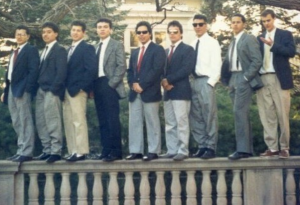
Sigma Lambda Beta: On April 6th, 1989 the Zeta Chapter of Sigma Lambda Beta International Fraternity Inc. was founded by 8 men at the University of Michigan. This organization has remained active on campus for almost 30 years now, and has an overall chapter membership of 150 brothers. The fraternity colors are royal purple and pure white, and their mascot is the White Stallion Mustang. This organization was founded on the pillars of brotherhood, scholarship, community service, and cultural awareness.
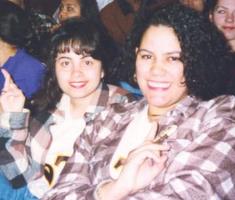
Delta Tau Lambda: On April 2nd, 1994 the Alpha Chapter of Delta Tau Lambda Sorority Inc. was created by 2 women here at the University of Michigan. This is the only Latinx-based Greek lettered organization that was founded at the University of Michigan, and has remained on campus for almost 25 years. Their colors are gold, brown, and cream, and their mascot is the African Lion. The main objectives of this sorority are academic excellence and community service, so that they can help create change in the Latinx community as well as other communities of color.
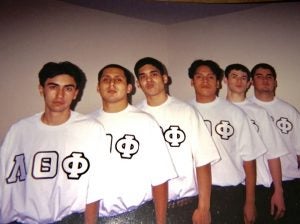
Lambda Theta Phi: On November 21st, 1997 the Alpha Omicron chapter of Lambda Theta Phi Latin Fraternity Inc. was founded at the University of Michigan by 6 men. This organization has been on campus for 20 years, and it was the first chapter established in the Midwest. The fraternity colors are brown and white, and their mascot is the Conquistador. Their principles are academic excellence, brotherhood, leadership, Latino unity, and service.

Sigma Lambda Gamma: On October 17th, 1999 the Beta chapter of Sigma Lambda Gamma National Sorority Inc. was founded at the University of Michigan by 10 women. This organization has been on campus for close to 20 years, and is the largest and fastest growing Latina-based multicultural sorority in the country. Their colors are shocking pink and majestic purple, and their mascot is the purple panther. The sorority principles are morals & ethics, social interaction, academics, community service, and cultural awareness.
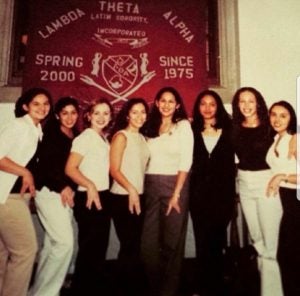
Lambda Theta Alpha: On January 23rd, 2000 the Beta Omicron Chapter of Lambda Theta Alpha Latin Sorority Inc. was founded by 8 women at the University of Michigan. This organization has been on campus for close to 20 years, and is the first Latina sorority in the country. The sorority colors are burgundy and grey, and were founded on the principles of unity, love, and respect.

Chi Upsilon Sigma: On August 28th, 2010 Chi Upsilon Sigma National Latin Sorority Inc. was founded by 8 women at the University of Michigan. This organization has been on campus for close to 10 years, and is the first and only chapter in the state of Michigan. The sorority colors are red, black, and beige, and their symbol is the almighty owl. The values of Chi Upsilon Sigma are leadership, sisterhood, service, and character.

Phi Iota Alpha: After disbanding back in the 1950s, Phi Iota Alpha was brought back to campus in the early 2000s, and then again more recently in the Fall of 2017. The fraternity colors are gold, navy blue, red, and white, and the fraternal symbol is a lion. Phi Iota Alpha is dedicated to the promotion and preservation of Latin American Culture.
Each of these organizations has had an impact on the overall campus community. Members from these organizations have helped create and plan many different programs and organizations on campus such as La Celebración Latina (Latino Graduation), Multicultural Greek Council, ALMA, and La Casa. Members of these organizations have also advocated for the needs of students on campus, and have helped provide students of color with a family away from home. Ultimately, this second wave of Latinx Greeks is a result of Latinx activism and the civil rights movement.They were and continue to be organizations that are dedicated towards service to communities of color and the betterment of society as a whole.For the past 30 years, they have provided a crucial support system for for their members as well as the Latinx community as a whole through outreach, cultural, and philanthropic events.
While it is important to acknowledge the long history of Latinx greek life in the United States, and the different “waves” of activity that have characterized this history, it is crucial to note the differences between early Latin American fraternities and the Latinx lettered organizations that emerged in the 1980s and 1990s. Early organizations struggled to sustain themselves as their largely foreign-born members returned to their home countries: their dreams, for the most part, lay elsewhere. Our dreams are here. Indeed, Latinx Greek Life today has evolved to become a community within itself on campus, and across the country. Looking at the current state of Latinx Greek Life at the University of Michigan, it can be inferred that both the numbers of organizations as well as members of these organizations will continue to grow, along with the growing demographic of Latinx students in higher education. In the past academic year alone, 34 new members have joined Latinx greek lettered organizations. Despite the important differences between Latinx Fraternities of the early 20th century, and Latinx greek life today, both share the desire to create a home away from home and imagine a better future. Latinx greek life has grown into a large community of both leaders and friends at the University of Michigan, who utilize their organizations to better serve the needs and wants of all people.

